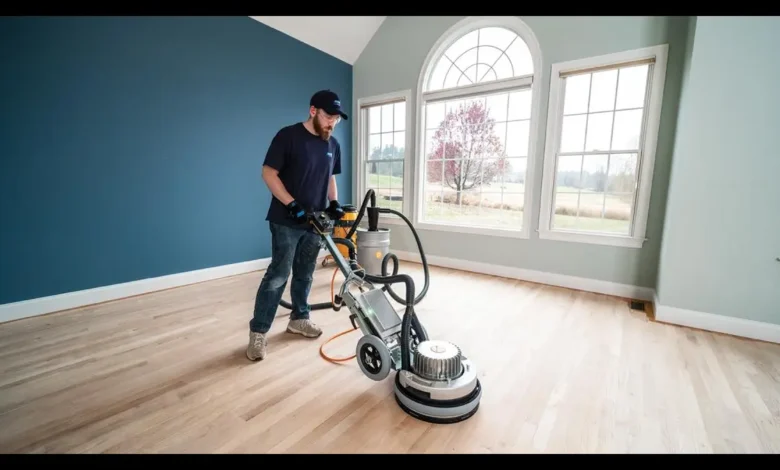Introduction to Floor Sanding Services

Floor sanding services are essential for restoring the beauty and functionality of hardwood floors. Over time, wear and tear, scratches, and stains can leave your flooring looking dull and aged. Sanding removes the top layers of the wood, revealing the fresh, untouched surface beneath. This process, combined with refinishing, can bring back the original charm of your floors, making them look as good as new. Whether for residential or commercial spaces, floor sandingservices offer a cost-effective way to maintain and enhance the value of your property.
The Benefits of Floor Sanding
One of the primary advantages of floor sanding is its ability to rejuvenate your flooring. Sanding removes imperfections such as scratches, dents, and stains, giving your floors a smooth and flawless finish. Additionally, it helps in maintaining the structural integrity of the wood by eliminating weak or damaged areas.
Refinished floors also improve indoor aesthetics, creating a fresh and polished look that complements any decor style. Moreover, smooth and well-maintained floors are easier to clean and reduce the accumulation of dust and allergens, contributing to a healthier indoor environment. For property owners, a professionally sanded and finished floor can significantly increase the market value and appeal of their property.
The Floor Sanding Process
The floor sanding process involves several critical steps to achieve the best results. First, the area is prepared by removing all furniture and ensuring the surface is free of debris. Next, the sanding equipment is used to remove the old finish and top layer of the wood. This process usually requires multiple passes with different grades of sandpaper, starting with coarse grit to remove imperfections and finishing with fine grit for a smooth surface.
After sanding, the floor is cleaned to eliminate dust and residue. Finally, a protective finish, such as varnish, oil, or lacquer, is applied to enhance the wood’s appearance and protect it from future damage. The choice of finish depends on the desired look and level of durability required.
Types of Floors Suitable for Sanding
Not all floors are suitable for sanding, but hardwood floors are the most common candidates. Solid hardwood and engineered wood floors can typically be sanded multiple times during their lifespan. However, laminate flooring and some types of engineered wood with thin veneers are not suitable for sanding due to the risk of damaging the surface.
Different types of wood, such as oak, maple, and pine, respond differently to the sanding process. Professional floor sanding services understand these variations and tailor their approach to the specific type of wood, ensuring optimal results.
Hiring a Professional Floor Sanding Service
While DIY sanding may seem like a cost-saving option, hiring a professional service ensures a higher quality finish and avoids potential mistakes. Professionals have the expertise, tools, and experience to handle different types of flooring and finishes effectively. They can also identify and address underlying issues, such as warped or loose boards, before sanding begins.
When choosing a floor sanding service, look for a company with a solid reputation and positive customer reviews. Request a detailed quote and inquire about the materials and techniques they use. A reliable service provider will offer a clear timeline and guarantee their work, giving you peace of mind throughout the process.
Maintenance Tips for Sanded Floors
Once your floors have been sanded and refinished, proper maintenance is key to preserving their appearance and durability. Regular cleaning with a soft broom or vacuum designed for hardwood floors helps prevent scratches from dirt and debris. Avoid using harsh chemicals or excessive water, as these can damage the finish.
Use protective pads under furniture legs to prevent scratches and consider using area rugs in high-traffic areas. Reapply the protective finish periodically to maintain the wood’s luster and protection. Following these tips will ensure your floors remain in excellent condition for years to come.
The Cost of Floor Sanding Services
The cost of floor sanding services can vary based on several factors, including the size of the area, the type of wood, and the condition of the flooring. On average, professional sanding services charge per square foot, with additional costs for refinishing and repairs. While this may seem like a significant investment, the long-term benefits far outweigh the initial expense.
Many service providers offer free consultations and estimates, allowing you to budget accordingly. Keep in mind that opting for a reputable and experienced company may cost more upfront but will save you money in the long run by delivering high-quality results that last.
Eco-Friendly Floor Sanding Options
For environmentally conscious homeowners, many floor sanding services now offer eco-friendly options. These include using low-VOC (volatile organic compound) finishes, dust-free sanding equipment, and sustainable materials. These practices not only reduce environmental impact but also create a safer and healthier indoor environment for you and your family.
Conclusion
Floor sanding services play a crucial role in maintaining and enhancing the beauty of hardwood floors. Whether you’re restoring an old floor or giving a modern space a new look, sanding can make a dramatic difference. By understanding the process, benefits, and maintenance requirements, you can make informed decisions and enjoy the timeless elegance of beautifully finished floors. Hiring a professional service ensures a hassle-free experience and long-lasting results, making it a worthwhile investment for any property owner.





